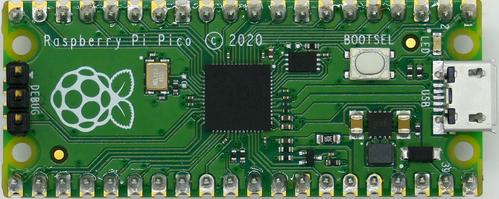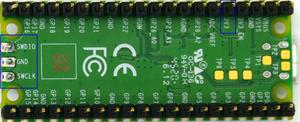Difference between revisions of "Raspberry Pi Pico"
(→RAM Projects) |
(→Example Projects) |
||
| Line 40: | Line 40: | ||
==Example Projects== |
==Example Projects== |
||
| − | To run the following example projects the following prerequisites need to be met: |
||
| − | * [https://www.segger.com/downloads/jlink/#J-LinkSoftwareAndDocumentationPack J-Link software] V6.98c or later |
||
| − | * J-Link HW revision 11 or later (J-Link Edu Mini and J-Trace Pro V1 or later also supported) |
||
| − | * [https://www.segger.com/products/development-tools/embedded-studio/ SEGGER Embedded Studio] V5.40c or later |
||
| − | * [https://www.segger.com/products/development-tools/ozone-j-link-debugger/ Ozone] V3.22c or later |
||
===RAM Projects=== |
===RAM Projects=== |
||
| Line 50: | Line 45: | ||
===QSPI Projects=== |
===QSPI Projects=== |
||
| + | |||
| − | * [[Media:RasPi_Pico_RP2040.zip | QSPI blinky]] |
||
| + | To run the following example projects the following prerequisites need to be met: |
||
| + | * [https://www.segger.com/downloads/jlink/#J-LinkSoftwareAndDocumentationPack J-Link software] V7.64e or later |
||
| + | * J-Link HW revision 11 or later (J-Link EDU Mini and J-Trace PRO V1 or later also supported) |
||
| + | * [https://www.segger.com/products/development-tools/embedded-studio/ SEGGER Embedded Studio for ARM] V6.30 or later |
||
| + | |||
| + | [[Media:RasPi_Pico_RP2040.zip | QSPI blinky]] |
||
Revision as of 11:49, 11 May 2022
The Raspberry Pi Pico is a Raspberry Pi RP2040 evaluation board. It is the first MCU evaluation board published by Raspberry Pi.
Contents
Features (selection)
- RP2040 MCU
- 2MB on board QSPI flash
- Micro USB-B 1.1
- Temperature sensor
- On board LED
- external debug connector pads
For further information please refer to the Rapberry Pi Pico web page
Setting up with J-Link
The Raspberry Pi Pico evaluation board comes with an external SWD debug connector (3 pins: SWCLK, GND, SWDIO). To set the board up with J-Link, the following steps are required:
- Solder a 3-pin pin strip to the debug connector pads.
-
Solder a pin Strip to the GPIO pads of the evaluation board. The relevant pad is Pad 36 (3V3(OUT))
-
Connect the J-Link to the evaluation board, using jumper wires as follows:
Pin RP Pico Pin J-Link Signal "DEBUG" "SWCLK" 9 SWCLK "DEBUG" "GND" 4 GND "DEBUG" "SWDIO" 7 SWDIO "3V3" Pad 36 1 VTref
Note: For a more reliable, simpler solution, the SEGGER Flying Wire Adapter is recommended.
Example Projects
RAM Projects
Refer to RAM Projects for the Raspberry Pi RP2040.
QSPI Projects
To run the following example projects the following prerequisites need to be met:
- J-Link software V7.64e or later
- J-Link HW revision 11 or later (J-Link EDU Mini and J-Trace PRO V1 or later also supported)
- SEGGER Embedded Studio for ARM V6.30 or later

